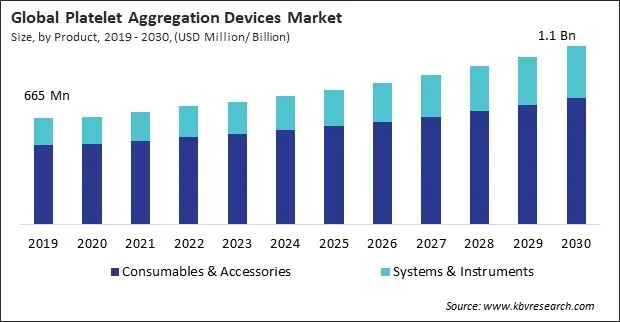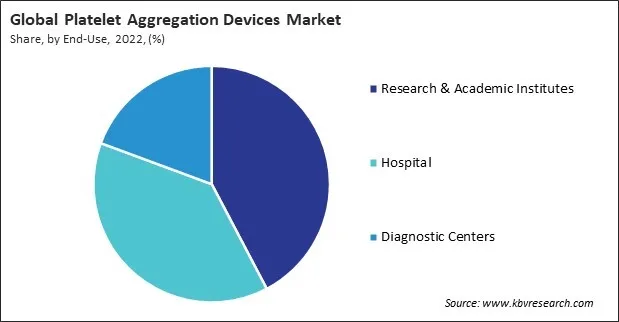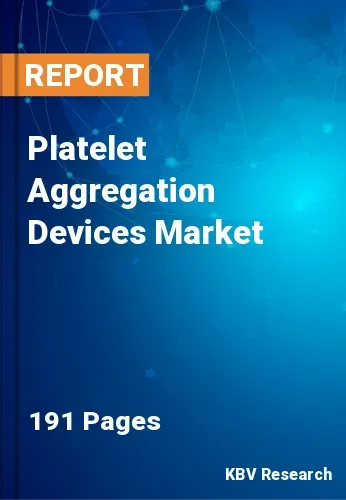“Global Platelet Aggregation Devices Market to reach a market value of USD 1.1 Billion by 2030 growing at a CAGR of 5.5%”
The Global Platelet Aggregation Devices Market size is expected to reach $1.1 billion by 2030, rising at a market growth of 5.5% CAGR during the forecast period.
The Asia Pacific region witnessed a steady rise in healthcare expenditure, reflecting growing investments in healthcare infrastructure, technological advancements, and the adoption of advanced medical devices, including these devices. Consequently, the Asia Pacific region would acquire nearly 25% of the total market share by 2030. The region faced an increasing prevalence of platelet-related disorders and cardiovascular diseases. As awareness about these conditions grew, there was a heightened focus on the importance of platelet function analysis for accurate diagnostics and treatment planning. Hence, the segment will expand rapidly in the upcoming years.

Worldwide, cardiovascular diseases, such as atherosclerosis and coronary artery disease (CAD), are the primary causes of morbidity and mortality. Platelet aggregation assays are critical in evaluating platelet function, which is a fundamental component in the pathogenesis of cardiovascular disorders. In addition, the information obtained from these devices is instrumental in tailoring antiplatelet therapy. Different individuals may exhibit varying responses to antiplatelet medications. Thus, these factors will assist in the growth of the market. Additionally, Personalized medicine involves tailoring medical decisions and treatments to the individual characteristics of each patient. These devices enable clinicians to perform individualized assessments of platelet function, considering factors such as responsiveness to stimuli and variations in platelet activity. In addition, personalized antiplatelet therapy minimizes the risk of adverse reactions by avoiding unnecessary exposure to medications that may be less effective or associated with a higher risk of side effects. Thus, these factors will result in enhanced growth in the market.
Moreover, In the initial phases of the pandemic, widespread disruptions in global supply chains impacted the production and distribution of these devices. Lockdowns, restrictions, and logistical challenges led to delays in manufacturing processes, affecting the availability of these critical medical devices. Additionally, the pandemic accelerated the adoption of telemedicine and remote healthcare monitoring. These devices that could be utilized remotely or integrated with telemedical platforms gained prominence. Therefore, the COVID-19 pandemic moderately impacted the market.
However, these devices often come with a substantial initial investment, including the purchase of the equipment itself. This upfront cost can strain the budgets of healthcare facilities, especially those operating with limited financial resources. Furthermore, consumables, such as reagents and test kits, are essential for platelet aggregation tests. The recurring expenses associated with purchasing these consumables contribute to the device's overall cost. Thus, these factors will limit the growth of the market.


Based on product, the market is segmented into systems & instruments and consumables & accessories. The systems and instruments segment held a significant revenue share in the market in 2022. Ongoing technological advancements in these devices have led to the development of sophisticated systems and instruments. These advancements include improved sensors, automation, and integration with digital platforms, enhancing the overall performance of platelet aggregation assessments. Therefore, these factors will help in the growth of the segment.
Based on end-use, the market is divided into hospital, diagnostic centers, and research & academic institutes. In 2022, the hospital segment witnessed a substantial revenue share in the market. Hospitals heavily rely on these devices for clinical diagnostics and monitoring of patients. These devices provide critical insights into platelet function, aiding in diagnosing and managing various hematological conditions and cardiovascular diseases. The ability to perform precise and timely platelet function assessments is integral to the overall healthcare delivery within hospital environments. Thus, these factors will pose lucrative growth prospects for the segment.

On the basis of application, the market is divided into clinical and research. The clinical applications segment recorded a considerable revenue share in the market in 2022. Ongoing advancements in diagnostic technologies related to platelet function have fueled the demand for these devices in clinical settings. The devices play a crucial role in assessing platelet function, aiding in diagnosing and managing various hematological disorders and cardiovascular conditions. Therefore, these factors will boost the demand in the segment.
Free Valuable Insights: Global Platelet Aggregation Devices Market size to reach USD 1.1 Billion by 2030
By region, the market is segmented into North America, Europe, Asia Pacific, and LAMEA. The North America segment procured the highest revenue share in the market in 2022. North America boasts a robust and advanced healthcare infrastructure, with well-established medical facilities and research institutions. The availability of state-of-the-art healthcare facilities created a conducive environment for adopting cutting-edge medical technologies, including these devices. Therefore, these factors will pose lucrative growth prospects for the segment.
| Report Attribute | Details |
|---|---|
| Market size value in 2022 | USD 739.6 Million |
| Market size forecast in 2030 | USD 1.1 Billion |
| Base Year | 2022 |
| Historical Period | 2019 to 2021 |
| Forecast Period | 2023 to 2030 |
| Revenue Growth Rate | CAGR of 5.5% from 2023 to 2030 |
| Number of Pages | 191 |
| Number of Tables | 329 |
| Report coverage | Market Trends, Revenue Estimation and Forecast, Segmentation Analysis, Regional and Country Breakdown, Porter’s 5 Forces Analysis, Company Profiling, Companies Strategic Developments, SWOT Analysis, Winning Imperatives |
| Segments covered | Product, Application, End-Use, Region |
| Country scope |
|
| Companies Included | AggreDyne, Inc., Bio/Data Corporation, Chrono-log Corporation, F. Hoffmann-La Roche Ltd., Haemonetics Corporation, Siemens Healthineers AG (Siemens AG), Werfen, S.A., Sysmex Corporation and Sienco, Inc. |
By Product
By End-Use
By Application
By Geography
This Market size is expected to reach $1.1 billion by 2030.
High prevalence of cardiovascular diseases are driving the Market in coming years, however, High cost of platelet aggregation devices restraints the growth of the Market.
AggreDyne, Inc., Bio/Data Corporation, Chrono-log Corporation, F. Hoffmann-La Roche Ltd., Haemonetics Corporation, Siemens Healthineers AG (Siemens AG), Werfen, S.A., Sysmex Corporation and Sienco, Inc.
The expected CAGR of this Market is 5.5% from 2023 to 2030.
The Research & Academic Institutes segment led dominated the Market by End-Use in 2022; there by, achieving a market value of $456.4 Million by 2030.
The North America region dominated the Market by Region in 2022, and would continue to be a dominant market till 2030; there by, achieving a market value of $402.2 Million by 2030.
Our team of dedicated experts can provide you with attractive expansion opportunities for your business.

 Drivers
Drivers
 Restraints
Restraints
 Opportunities
Opportunities
 Challenges
Challenges
